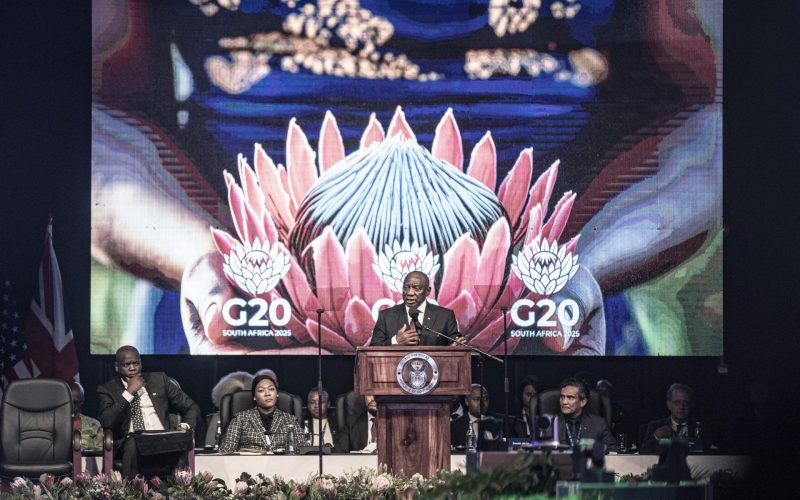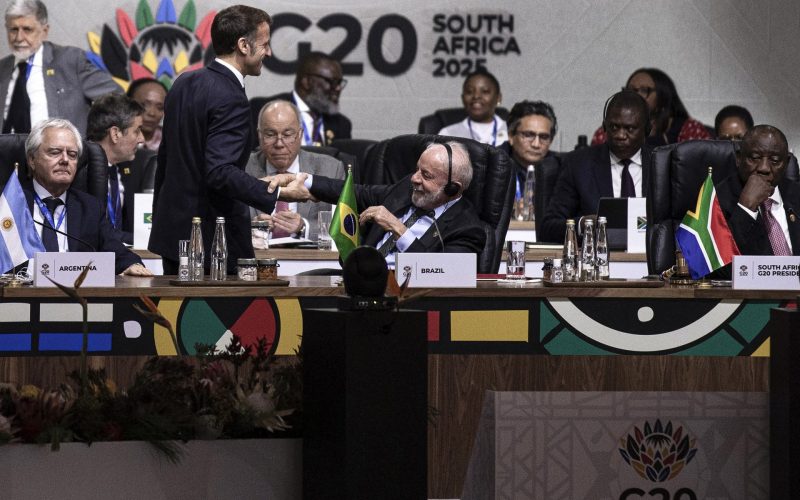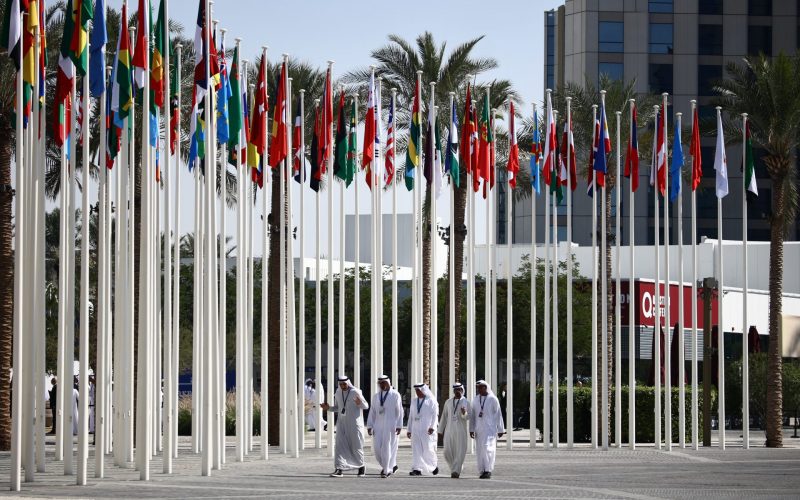Recommendations
- African governments should consider adopting ring-fencing policy measures for their development expenditure, including public expenditure reviews, medium-term expenditure frameworks, independent development funds with dedicated revenue streams, and statutory floors for specific development spending. They should also strive to formalise the connection between debt service reductions and increased development investment.
- African governments should proactively introduce measures to address the potential challenges that ring-fencing policy measures could encounter at the technical, political and institutional levels. These measures could include improving departmental coordination, developing inclusive processes of coalition building for development financing protection and developing sophisticated analytical skills and tools.
- African governments should position development finance as complementary to security priorities to leverage the increased availability of security-focused international financing.
- The international community should support ring-fencing development expenditure in African countries by providing technical assistance, aligning their assistance with national protection frameworks and working towards the reform of the international financial architecture to create a conducive environment to prioritise long-term development investment.
Executive summary
Africa is facing mutually reinforcing challenges, including trade fragmentation, security focused economic policies, fiscal limitations and technological disruption, which have created a development landscape of unprecedented complexity and constraint. At the same time, there is a systematic mismatch between Africa’s long-term development needs and the short-term fiscal and political pressures that dominate policymaking.
This policy brief argues that ring-fencing development expenditures is a potential pathway to reconciling this mismatch. Although there are many challenges spanning the technical, political and institutional domains, this policy brief outlines several policy mechanisms to institutionalise ring-fencing of development financing that have proven to be effective in a number of countries.
Introduction
Africa stands at a critical juncture. The continent faces unprecedented challenges in securing stable, sustainable financing to address its most essential development needs. In this turbulent landscape, calls to ring-fence development financing in Africa have become more frequent and more urgent than ever before. Ring-fencing, as a systematic approach to shielding critical development spending from volatility, brings the continuity and predictability needed to ensure that transformative, long-term development initiatives succeed.
This policy brief argues that ring-fencing development expenditures is a potential pathway to reconciling the mismatch between long-term development needs and short-term fiscal and political pressures. This brief provides an overview of the fundamental shifts in the global economic landscape that have converged to create an environment increasingly hostile to development financing. It then presents the structural case for and the economic logic of ring-fencing. Thereafter, it presents several policy options for comprehensive ring-fencing strategies. Finally, the brief explores implementation challenges and mitigation measures.
Development financing under threat
A growing barrier in the global trading system
The global trading system has regressed into fragmentation and protectionism. This shift has manifested in escalating tariff barriers, non-tariff trade restrictions and a growing emphasis on reshoring and ‘friend-shoring’ production. These are exemplified by the US’s Inflation Reduction Act, the EU’s Green Deal Industrial Plan, and China’s Made in China 2025 initiatives.
The WTO estimates that as of October 2024, import-restrictive measures implemented since 2009 affected goods worth about $3 trillion globally (12% of world imports), with developing economies experiencing disproportionate impacts.1World Trade Organization, WTO Trade Monitoring Report (WTO, November 20, 2024). More recently, on 2 April 2025, President Donald Trump initiated one of the most significant shifts in US trade policy in nearly a century by imposing a baseline 10% tariff on all imports and additional country-specific tariffs, ranging from 10% to 50% for countries designated as having ‘non-reciprocal trading practices’ with the US. The consequences for Africa are severe. Export-led growth strategies, which historically offered pathways for economic diversification and structural transformation, face mounting obstacles.2Karim El Aynaoui and Hinh T. Dinh, ‘Economic Development of the New South after the Washington Consensus’ (Geopolitiques, December 18, 2024).
The rise of security-focused economic policy
The rise of security-focused economic policy has had a compounding effect on the challenges of trade protection and fragmentation. The global economic landscape has been transformed, with security imperatives taking centre stage in the place of traditional development and trade principles. This ‘securitisation’ of economic policy impacts trade relations, investment screening, technology transfer, development assistance and international financial architecture.
Development assistance, crucial for the African continent, is increasingly conditioned on security cooperation, strategic alignment or counterterrorism initiatives. Foreign direct investment faces heightened scrutiny through national security reviews, particularly in sectors deemed strategic, such as telecommunications, energy and critical minerals – areas critical to Africa’s development. Technological cooperation faces new restrictions aimed at preventing sensitive technology transfer, potentially limiting African access to transformative innovations in renewable energy, digital infrastructure and agricultural productivity.
The UN’s Financing for Sustainable Development Report 2024 noted that the share of official development assistance allocated to security-related activities has more than doubled over the past decade, while the share dedicated to economic infrastructure and productive sectors has declined. For Africa, this shift presents a double challenge. First, it reduces available resources for traditional development priorities as global development partners redirect assistance towards security objectives. Second, it potentially distorts domestic resource allocation by incentivising African governments to align their spending patterns with donor security priorities rather than development needs. The risk is a progressive displacement of development financing by security expenditures, both externally and internally.
Africa’s severely constrained macroeconomic space
A succession of global shocks – from the 2008 global financial crisis to the COVID-19 pandemic and the economic fallout from the Ukraine conflict – has depleted fiscal buffers across Africa. Total external debt stock in sub-Saharan Africa more than doubled from $341 billion in 2010 to $864 billion by 2023, with several countries facing debt distress or default.3The World Bank Group, International Debt Report 2024 (The World Bank Group, 2024). This debt burden directly reduces fiscal space for development spending, as debt servicing consumes an ever-larger proportion of national budgets. In some African countries, debt service consumed as much as 49% of government revenues in 2023.4The World Bank Group, ‘Improving governance and delivering for people in Africa’ (Africa’s Pulse No. 31, The World Bank Group, April 23, 2025).
African governments also face mounting expenditure pressures from multiple directions, including rising military expenditures (more pronounced in North Africa), demographic shifts and climate change adaptation.
Technological disruption
In addition to the three geopolitical shifts outlined above that constrain Africa’s access to development finance, rapid technological change has disrupted traditional development pathways. The historical route to structural transformation through labour-intensive manufacturing and export-led growth – the path followed by East Asian economies in previous decades – has become increasingly difficult. Automation, robotics and artificial intelligence are fundamentally altering production processes, reducing manufacturing’s labour intensity and raising skill thresholds for meaningful economic participation. This ‘premature deindustrialisation’ phenomenon, as coined by economist Dani Rodrik, poses particular challenges for African economies with large pools of low-skilled labour.
The digital revolution simultaneously offers new opportunities through service-sector growth and technology-enabled productivity gains. However, capitalising on these opportunities requires substantial upfront investments in digital infrastructure, educational systems and regulatory frameworks – precisely the types of development expenditure that are most vulnerable to fiscal constraints.
These challenges – trade protection and fragmentation, security-focused economic policies, fiscal constraints and technological disruption – interact in mutually reinforcing ways. Trade barriers reduce export opportunities and foreign exchange earnings, exacerbating fiscal pressures. Fiscal constraints limit investments in skills development and infrastructure, hampering adaptation to technological change. Technological disruption alters comparative advantages, further complicating trade integration. Security concerns divert resources from development priorities while potentially distorting development strategies. The result is a development landscape of unprecedented complexity and constraint.
The structural case for ring-fencing development expenditures
The urgency surrounding ring-fencing development expenditures stems from a fundamental structural mismatch between Africa’s long-term development needs and the short-term fiscal and political pressures that dominate policymaking on the continent. This mismatch creates systematic biases against optimal levels of development investment, even if such investment were to yield substantial long-term returns.
Within the challenging environment described above, development expenditures are particularly vulnerable. Unlike social transfers with immediate beneficiaries or security spending with powerful institutional advocates, investments in education, infrastructure and sustainable development often lack robust political constituencies. Their benefits typically materialise over longer time horizons than those of electoral cycles, creating political economy challenges when it comes to prioritisation. Without systematic protection, these investments become easy targets for budget cuts during periods of fiscal consolidation, perpetuating underinvestment in the very foundations of sustainable growth. Current budget protection mechanisms are inadequate. Existing safeguards – such as constitutional guarantees for specific sectors or donor-imposed conditions – often prove to be insufficient in practice.
The consequences of failing to protect development expenditures extend far beyond immediate budget allocations. Chronic underinvestment in human capital development, infrastructure and productive capacity has compounding negative effects over time.
Educational deficits today translate into productivity gaps tomorrow. Infrastructure backlogs raise business costs and hamper competitiveness for decades. Climate adaptation deficits increase vulnerability to environmental shocks, potentially triggering humanitarian crises and migration pressures.
The economic logic of ring-fencing
Ring-fencing development is a potential pathway to reconciling the mismatch between Africa’s long-term development needs and short-term fiscal and political pressures.
By ring-fencing development expenditures, governments can insulate these investments from short-term fiscal pressures, helping to align actual expenditure patterns with long-term development objectives. Furthermore, ring-fencing can protect complementary investments across sectors, which will help realise networked benefits. For example, investments in educational outcomes will improve when health and nutrition programmes succeed.
Perhaps most fundamentally, ring-fencing development expenditures represents a commitment to intergenerational equity. Development investments essentially transfer resources across time, with current generations bearing costs to benefit future ones.
Standard political processes, focused on current constituencies, systematically undervalue future benefits. Ring-fencing mechanisms provide a partial corrective to this bias, ensuring that the interests of future generations receive appropriate weight in current resource allocation decisions.
In the African context, where development challenges are particularly acute and fiscal pressures especially intense, the case for systematic ring-fencing is compelling.
The continent faces a fundamental development financing gap estimated by the African Development Bank at $68–$108 billion annually for infrastructure alone.5African Development Bank, African Economic Outlook 2018 (AfDB, 2018) xvi. Closing this gap requires not just mobilising additional resources but also ensuring that existing and future resources are effectively protected and directed towards priority development needs, even amid competing demands and fiscal constraints.
Comprehensive strategies for ring-fencing development finance
Policy measure 1: Review and prioritisation of public expenditures
The improvement in fiscal balances across sub-Saharan Africa – with overall deficits declining from 6.3% of GDP in 2020 to 4% in 2024 – provides an opportunity to systematically review and reprioritise expenditures.6The World Bank Group, ‘Transforming Education for Inclusive Growth’ (Africa’s Pulse No. 30, The World Bank Group, October, 2024), 29. Public expenditure reviews (PERs) provide analytical foundations for effective ring-fencing by identifying high-return investments, inefficient allocations and implementation bottlenecks. PERs also enable more strategic protection of essential development expenditures, even when fiscal constraints necessitate overall spending reductions. To be effective, PERs must be institutionalised and regularised. They must incorporate both technical efficiency analysis and broader development impact assessment, and they must engage stakeholders beyond finance ministries by building broader constituencies for expenditure reform and protection of priority investments.
Tanzania’s experience with institutionalised PERs demonstrates their potential contribution to development financing protection. Since 1997, Tanzania has conducted annual PERs across major sectors, using the findings to guide budget allocations and protect priority investments. These reviews are conducted by the government with inputs from relevant departments, depending on the sector under review as well as relevant international organisations that provide technical assistance. During periods of fiscal constraint, these reviews have enabled the government to maintain or increase financing for high-return investments in primary education, rural infrastructure and preventive healthcare while reducing less productive expenditures.
Policy measure 2: Medium-term expenditure frameworks with statutory protection
Medium-term expenditure frameworks (MTEFs) represent a powerful tool for embedding development priorities within budget processes. By extending planning horizons beyond annual budget cycles, MTEFs allow governments to align fiscal allocations with strategic development goals. They establish formal commitment mechanisms that extend beyond annual budget cycles and facilitate explicit trade-off analysis across time periods, highlighting the long-term costs of development spending cuts. They also create structured processes for managing fiscal adjustments when they become necessary, reducing the likelihood of ad hoc cuts to development investments.
Strategic priorities must be clearly defined, measurable and linked to long-term development frameworks for MTEFs to be effective. In addition, resource allocations within the MTEF must be realistic and based on credible revenue projections.
South Africa was among the first African countries to adopt an MTEF, implementing it in 1998 under the leadership of finance minister Trevor Manuel. The MTEF marked a significant shift towards multi-year budgeting, aiming to improve fiscal discipline, transparency and the alignment of public spending with national priorities. This reform played a key role in strengthening South Africa’s public financial management system during its post-apartheid economic transition and has since served as a model for other African countries pursuing budgetary reforms.
Rwanda’s experience with MTEFs illustrates their potential as ring-fencing mechanisms. Following the 1994 genocide, Rwanda established a robust MTEF process explicitly linked to its Vision 2020 development strategy. The framework identified priority sectors – including education, health, agriculture and infrastructure – and established minimum budget shares for each, protected across annual budget cycles. Despite numerous fiscal pressures, including aid volatility and regional security challenges, Rwanda maintained or increased allocations to these priority sectors over multiple years. This budgetary consistency contributed significantly to Rwanda’s remarkable progress in human development indicators and economic growth over the past two decades.
Policy measure 3: Independent development funds with dedicated revenue streams
Independent funds and escrow accounts offer institutional mechanisms for protecting development financing from general budget pressures. These structures operate outside the regular budget process and establish dedicated financing channels for specific development purposes, typically governed by special rules regarding resource mobilisation, management and disbursement. These include sovereign wealth funds (capitalised from natural resource revenues or fiscal surpluses); infrastructure funds (capitalised through dedicated revenue streams, such as fuel levies or utility charges); climate adaptation funds (often blending domestic and international resources); and sector-specific funds for education, health or agricultural development.
These mechanisms insulate development financing from annual budget negotiations and short-term fiscal pressures.
Botswana’s Pula Fund exemplifies the potential of sovereign wealth funds to protect development financing. Established in 1994, the fund receives a portion of the country’s diamond revenues and foreign exchange reserves. Its governance structure – combining professional investment management with parliamentary oversight – has enabled it to accumulate substantial assets while funding strategic development investments. During periods of fiscal contraction, including the 2008–2009 global financial crisis, the Pula Fund provided countercyclical financing that protected core development programmes from cuts. Kenya’s Roads Maintenance Levy Fund is another example.
For independent funds to effectively ring-fence development financing, they require governance structures that balance professional management with appropriate oversight. In addition, the revenue source must be stable and aligned with fund purposes, disbursement criteria must be clear and appropriate, and transparency mechanisms must enable public scrutiny of fund operations.
Policy measure 4: Statutory protection of development spending
Legal frameworks can establish binding minimum allocations for priority sectors. These statutory protections typically take the form of constitutional provisions or legislation mandating specific budget shares or absolute spending levels for sectors such as education, health, infrastructure, or research and development. These provisions raise the political and administrative barriers to reallocation, even during periods of fiscal contraction. They transform development financing from a discretionary choice into a legal obligation, fundamentally altering budgetary dynamics.
A successful example of this is article 212 of the Brazilian Constitution that mandates that the federal government allocate at least 18% of tax revenues to education, while states and municipalities must allocate a minimum of 25%.7Nina Beatrix Stocco Ranieri, ‘Financing Public Education in Brazil: The Constitutional Framework’ (Funding Education, March 16, 2010). This constitutional floor has protected education financing through multiple economic cycles and political transitions, contributing to significant improvements in Brazil’s educational access and quality over recent decades.
Legal provisions must be specific enough to prevent circumvention while flexible enough to accommodate changing circumstances. To this end, they must have enforcement mechanisms and monitoring systems, and they should be complemented by performance frameworks that assess not just spending levels but also development outcomes.
Policy measure 5: Debt and debt service relief mechanisms
As debt burdens increasingly constrain fiscal space across Africa, debt management strategies must be explicitly linked to development financing protection. This linkage can occur through several channels, including debt restructuring negotiations, debt sustainability analyses and debt-for-development swaps. Formalising the connections between debt service reductions and increased development investments essentially converts external obligations into domestic development resources.
The Heavily Indebted Poor Countries (HIPC) Initiative and Multilateral Debt Relief Initiative (MDRI) demonstrated this potential, requiring participating countries to redirect debt service savings towards poverty reduction expenditures tracked through dedicated budget lines. Countries that effectively implemented these requirements, such as Ghana and Tanzania, saw significant improvements in health, education and infrastructure financing, protected from other budget pressures.
More recently, innovative mechanisms such as debt-for-climate swaps have emerged as potential tools for ring-fencing specific development investments. Seychelles’s 2015 debt-for-nature swap with the Paris Club, facilitated by The Nature Conservancy, converted $21.6 million of external debt into domestic financing for marine conservation, protected through an independent conservation trust fund.8The Commonwealth, ‘Case Study: Innovative Financing – Debt for Conservation Swap, Seychelles’ (The Commonwealth, November 28, 2020). Similar mechanisms could be applied to other development priorities, creating protected financing streams for education, renewable energy or digital infrastructure.
Debt restructuring agreements must include specific, measurable commitments regarding development expenditures. Meanwhile, transparent monitoring systems must track the redirection of resources from debt service to development investments, and domestic institutions must have the capacity to effectively utilise debt relief proceeds.
Implementation challenges and responses
While the theoretical case for ring-fencing development expenditures is compelling, its practical implementation faces substantial challenges. These challenges span technical, political and institutional domains, requiring nuanced responses tailored to specific country contexts.
Technical challenges include the complexity of defining and measuring development expenditures (for example, what constitutes ‘development investments’), the difficulty of determining optimal protection levels and the challenge of maintaining flexibility while ensuring protection. Addressing these requires establishing clear, context-specific frameworks for identifying protected expenditures, as well as sophisticated analytical tools to assess both development returns of protected expenditures and the opportunity costs of reduced flexibility. It is important to note that effective ring-fencing mechanisms should include safety valves for temporary reallocations in exceptional circumstances (economic shocks and natural disasters, for example) while preventing these exceptions from becoming the rule.
Political challenges include navigating competing interests, managing cross-temporal trade-offs and sustaining commitment across political transitions. Protected expenditures for some sectors implicitly constrain resources available for others. Addressing these challenges requires an inclusive consultation process of coalition building for development financing protection. This process should include transparent communication about the long-term benefits of stable development investments and phased implementation that allows for gradual adjustment to new allocation patterns.
Navigating the mismatch between political time horizons and development payoff periods may require political incentives for long-term thinking. These might include recognition systems that acknowledge political leadership in establishing protection mechanisms; communication strategies that connect current investments to visible future benefits; and institutional designs that allow current politicians to claim credit for establishing systems that will deliver results beyond their terms.
Furthermore, effective ring-fencing mechanisms require continuity beyond single administrations. Strategies include embedding protections in constitutions or legislation, requiring supermajorities to amend; establishing independent oversight bodies with staggered appointments spanning multiple administrations; and creating international commitments that raise the costs of policy reversal.
Implementing effective ring-fencing mechanisms could encounter institutional challenges. These could be addressed through targeted capacity development, integrated with protection mechanisms such as technical assistance components within MTEF implementations; twinning arrangements between new and established funds; and South–South knowledge exchange on statutory protection frameworks. Importantly, capacity development should focus not just on technical skills but also on the analytical capabilities needed to make strategic allocation decisions within protection parameters.
Improved coordination across finance ministries, line agencies, planning departments and often subnational governments may be required when protection mechanisms span multiple sectors and may require establishing formal coordination mechanisms with appropriate authority and accountability.
Furthermore, establishing comprehensive monitoring systems that track both financial flows and development outcomes is necessary to ensure compliance with protection parameters, creating transparency and accountability as well as assessing the development impact of protected expenditures. This provides useful evidence to refine protection frameworks over time.
Addressing counterarguments and limitations
While ring-fencing development expenditures offers significant benefits, potential drawbacks must be acknowledged and mitigated. Critics of ring-fencing development expenditures have raised several valid concerns, including potential rigidities, allocative inefficiencies and governance risks associated with protection mechanisms.
To mitigate potential rigidity concerns, it is important to calibrate protection parameters to maintain essential flexibility. This involves including well-defined escape clauses for genuine emergencies while erecting high procedural barriers to prevent their casual invocation.
Regular reviews should assess protection levels against changing circumstances, allowing for gradual adjustments that maintain stability while avoiding rigidity.
Another concern relates to reduced incentives for efficiency if certain budget allocations are protected. Mitigating this requires integrating performance assessments with protection mechanisms, such as minimum allocations with additional performance-based financing that rewards effectiveness.
Implementing protection mechanisms may increase administrative burdens, which require streamlined, transparent processes and clear institutional responsibilities that balance robustness with simplicity. Where possible, ring-fencing should build on existing systems rather than create parallel structures and should be implemented in phases to allow capacity to develop alongside the frameworks.
By creating dedicated funding channels outside normal budget processes, ring-fencing mechanisms may inadvertently reduce transparency and accountability and increase the risk of capture and corruption, particularly when governance institutions are weak. Mitigating this risk requires robust governance frameworks for protected expenditures. Protection frameworks should strengthen rather than circumvent public financial management systems, potentially establishing higher standards for protected expenditures than general budget allocations.
Introducing ring-fencing may face political resistance from competing interests. This requires building broad-based coalitions that highlight the long-term benefits for all stakeholders by emphasising the potential of ring-fencing to expand the resource base through enhanced growth and stability.
In addition to the above risk-specific requirements, systemic risk-mitigating measures should be introduced, including regular reviews and regional knowledge sharing.
Navigating the security-development nexus
The relationship between security and development is inherently bidirectional. Development deficits – manifesting in youth unemployment, resource scarcity and limited economic opportunities – can become drivers of insecurity through radicalisation, migration pressures and resource conflicts. Conversely, insecurity undermines development through destroyed infrastructure, displaced populations and deterred investment. This interdependence suggests that protecting development financing serves security objectives, while security investments can create conditions for development progress. Therefore, the rising prominence of security concerns in national and international policy frameworks presents not only challenges but also opportunities for development financing protection.
Rather than positioning development protection as a way of competing with security priorities, it should be framed as complementary – addressing root causes of insecurity through sustainable economic opportunities, inclusive governance and resilient communities. This framing can help build broader constituencies for development financing protection, including security-focused stakeholders who recognise the stabilising effects of sustained development investment. Caution must be exercised in avoiding the securitisation of development, ensuring that development and security expenditures remain delineated. For example, infrastructure investments remain development expenditures, even if they yield security benefits. In addition, military training programmes remain security expenditures, even if they facilitate economic activity.
Furthermore, the increased availability of security-focused international financing could be leveraged as a complement to development financing in specific contexts, if approached strategically. Strategic approaches include negotiating dual-purpose investments that serve both security and development objectives, such as infrastructure connecting remote regions or vocational training for at-risk youth. They also include sequencing security and development interventions to maximise their complementarity, with security operations creating space for subsequent development investments protected through ring-fencing mechanisms.
Several African countries have successfully navigated this terrain. Niger has negotiated with international security partners to include development components within security-focused assistance packages, directing resources towards education and economic opportunities in border regions that are vulnerable to extremist recruitment. Côte d’Ivoire has implemented ‘security development corridors’ where security operations create stabilised zones. These have subsequently been prioritised for protected development investments, particularly in agricultural value chains and rural infrastructure.
The international community’s role
While the primary responsibility for ring-fencing development expenditures rests with African governments, international partners play crucial enabling roles. Their supportive actions should focus on creating enabling conditions, providing technical support and aligning their own assistance with national protection frameworks.
This can be done through the provision of technical assistance (tailored to each country’s specific protection strategies and institutional context). Priority areas for technical assistance include strengthening public financial management systems to enable credible MTEFs; developing transparent tracking systems for protected expenditure categories; building evaluation capabilities to assess the development impact of protected investments; and strengthening governance frameworks for independent development funds. This support should emphasise knowledge transfer and institutional strengthening rather than temporary external management, enabling sustainable national implementation of protection frameworks.
Furthermore, international development partners’ own financing practices significantly influence the effectiveness of national ring-fencing efforts. This aligns external assistance with national protection frameworks, substantially enhancing their effectiveness and sustainability. Alignment strategies include channelling assistance through protected national budget categories wherever possible; matching external funding cycles with national MTEFs; establishing multi-donor trust funds that reinforce rather than duplicate independent national funds; and harmonising reporting requirements to reduce administrative burdens on national systems. In Uganda, development partners have progressively aligned their assistance with the country’s medium-term expenditure framework, with joint review processes that assess sectoral performance against protected expenditure targets. In Ethiopia, international climate financing increasingly flows through the country’s Climate Resilient Green Economy Facility, reinforcing this protected financing channel rather than creating parallel structures.
Beyond the bilateral level, at a global level, reforming the international financial architecture is vital for African governments’ ability to protect development financing. Current debt sustainability frameworks, dominated by short-term fiscal metrics, often incentivise cuts to development expenditures during times of economic stress. Conditionalities attached to international financing frequently target public investment for reduction during fiscal consolidation, despite its long-term growth implications.
Reform priorities include integrating development financing protection into debt sustainability analyses, with explicit consideration given to how fiscal adjustments affect critical development expenditures. They also include establishing international financing mechanisms that provide countercyclical support specifically for protected development categories during economic downturns, ensuring continuity of essential investments.
Recent innovations provide promising foundations for further progress. The International Monetary Fund’s adaptation of its Sovereign Risk and Debt Sustainability Framework to incorporate climate vulnerabilities represents a step towards more development-sensitive analysis. The African Development Bank’s countercyclical support facility, which provides additional financing when countries face external shocks, offers a model for protecting development investments during crises.
Conclusion: From protection to transformation
Ring-fencing development expenditures is not merely a defensive strategy to preserve existing investments but also a transformative approach to development financing.
By establishing systematic protections for the foundations of sustainable growth – human capital formation, infrastructure development, climate resilience and productive capacity – ring-fencing mechanisms create enabling conditions for economic and social transformation. This is notwithstanding global uncertainty, fiscal constraints and shifting security priorities.
The imperative for such protection has never been more urgent. As Africa navigates the perfect storm of trade fragmentation, fiscal constraints, technological disruption and security-focused policy shifts, the risk of development financing being displaced by short-term pressures grows increasingly acute. Without systematic protection, the continent faces the prospect of chronic underinvestment in its most essential sectors, perpetuating vulnerability and impeding future possibilities.
Implementation will undoubtedly face challenges at the technical, institutional and political levels. Yet the alternative – continuing vulnerability of development investments to short-term pressures – carries far greater risks for Africa’s future.
The ultimate measure of successful ring-fencing lies not in protection for its own sake but in the development outcomes it enables. Protected investments in education should translate into improved learning outcomes and enhanced workforce capabilities.
Protected infrastructure financing should generate more reliable electricity, expanded transportation networks and more affordable connectivity. Protected climate investments should build resilience against environmental shocks and enable sustainable resource management.
In a world where self-interest often dominates international relations, the deliberate protection of development financing represents Africa’s best defence against external pressures and competing domestic demands. By ring-fencing these critical investments, Africa can maintain its path towards sustainable development, despite the formidable challenges confronting it in the global economic landscape.








